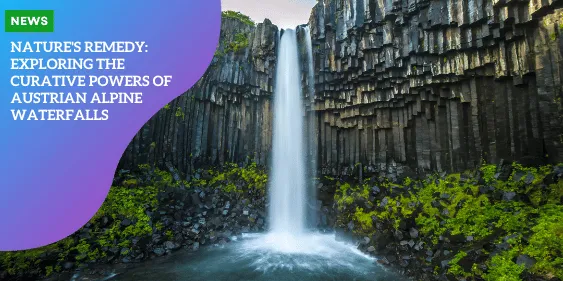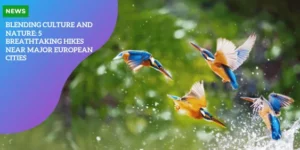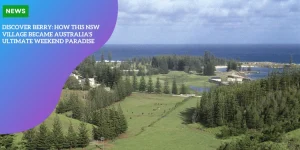Nature’s Remedy: Exploring the Curative Powers of Austrian Alpine Waterfalls

Krimml’s Pioneering Approach to Health Tourism
Nestled in the Austrian Alps, the town of Krimml is revolutionizing health tourism with its innovative practice of ecomedicine.
This approach, championed by the residents of Krimml, synergizes the natural environment with therapeutic tourism.
The goal is simple but profound: to transform the healing power of nature into real health benefits for visitors, especially those suffering from respiratory conditions.
Concept of Ecomedicine
The foundation of ecomedicine in Krimml was laid by Paracelsus Medical University Salzburg. Led by Dr. Arnulf Hartl, the university has been pivotal in developing this concept.
Ecomedicine merges the therapeutic potential of nature with medical science to treat modern health issues.
Specifically, it harnesses the pristine alpine environment to offer health solutions where traditional urban settings fall short. According to Dr. Hartl, “Urban-associated illnesses could be treated within a health tourism format in the Alps.
The Alps are like a green island in a sea of fine dust.”
New Economic and Therapeutic Opportunities
This innovative approach has opened numerous economic and therapeutic avenues for Krimml.
Beyond bringing health benefits to visitors, it has revitalized the town’s economy.
Hotels have redesigned their offerings to cater to allergy sufferers, creating a niche market that attracts tourists seeking relief from their conditions.
The rise in health tourism has also led to a surge in job opportunities, particularly benefiting local women who now fill high-qualified roles.
The transformation seen in Krimml underscores the symbiotic relationship between health and economic prosperity in the realm of ecomedicine.
With Krimml leading the way, the town serves as a model for how other regions can blend healthcare and tourism, ensuring both economic development and sustainable, health-focused growth.
The Healing Power of Krimml Waterfall
Krimml Waterfall, towering at an impressive height of 380 meters, is not just Europe’s largest waterfall — it is also a beacon of hope for those suffering from respiratory ailments.
This natural wonder generates a unique microenvironment teeming with health benefits, particularly for individuals living with asthma and chronic bronchitis.
Therapeutic Virtues of the Waterfall’s Water Cloud
The power of Krimml Waterfall lies in its water cloud, a natural mist composed of extremely fine water droplets.
Though these droplets are minuscule — 200 times smaller than those in a typical asthma spray — they pack a significant therapeutic punch.
When inhaled, the negatively charged droplets act like a natural anti-inflammatory, reducing lung inflammation and easing respiratory distress.
Benefits for Respiratory Ailments
Visitors to Krimml who suffer from respiratory issues like asthma and chronic bronchitis often find remarkable relief in the waterfall’s misty embrace.
Céline Nerbl, a frequent visitor, describes her experience: “We do a lot of breathing and inhalation exercises.
It opens my bronchial tubes, and since then, I’m no longer congested at all”.
Clinical studies back up these anecdotal reports, supporting the waterfall’s efficacy in alleviating respiratory symptoms.
Dr. Arnulf Hartl, head of the Institute of Ecomedicine, articulates this well: the fine, negatively charged droplets not only open up airways but also induce an immunological response that reduces lung inflammation.
The Krimml Waterfall represents a beautiful fusion of nature and medicine, with its unique environment offering a therapeutic retreat for those in need.
As visitors breathe in the healthful mist, they participate in a timeless tradition that marries natural beauty with human well-being.
This pathway to wellness creates a nurturing experience for all and sets the stage for regional innovations that will harmonize healthcare and nature.
Scientific Basis of Waterfall Therapy
Waterfall therapy leverages nature’s power in a unique way, especially at places like the Krimml Waterfall.
But what’s the science behind the therapeutic claims? The answer lies in the microscopic water droplets created by the falling water.
These droplets are 200 times smaller than those found in standard asthma inhalers.
Their small size allows them to be easily inhaled deep into the lungs.
Microscopic Marvels: Negatively Charged Droplets
These incredibly fine droplets carry a negative charge, which is key to their therapeutic potential.
When inhaled, they help reduce lung inflammation, providing relief for those suffering from respiratory conditions.
The negatively charged particles play a crucial role in modulating the immune response, lessening inflammation and promoting better respiratory health.
Backed by Science: Clinical Studies
Numerous clinical studies back these claims. Research conducted by Dr. Arnulf Hartl at the Paracelsus Medical University Salzburg has demonstrated significant reductions in lung inflammation among patients who undergo waterfall therapy at Krimml.
Patients, like Céline Nerbl, have reported noticeable improvements in their conditions, citing enhanced breathing and reduced congestion after therapy sessions.
Such anecdotal evidence is further corroborated by rigorous scientific studies, forming a strong basis for these therapeutic claims.
Waterfall therapy isn’t just a natural remedy; it’s a scientifically validated approach that offers new hope for those with respiratory ailments.
This innovative therapy is helping shape the future of health tourism, catalyzing both economic and therapeutic opportunities for Alpine regions like Krimml.
The HEALPS2 Project
Cataloging Alpine Natural Resources
The HEALPS2 Project, spearheaded by Dr. Arnulf Hartl and supported by the European Union’s Cohesion Policy, aims to catalog the diverse natural resources across Alpine regions.
With a budget of €2,417,603, 85% of which is funded by the EU, the project engages local stakeholders in France, Italy, Slovenia, Austria, Germany, and Switzerland.
The primary goal is to identify and list region-specific assets such as hiking trails, alpine pastures, raw milk products, and the cooler mountain air, all of which have potential therapeutic applications.
Development of Therapeutic Tourism
Leveraging these natural resources, the HEALPS2 Project is focused on developing tailored therapeutic tourism offerings.
By integrating the unique environmental attributes of the Alps, the project seeks to transform these regions into health havens.
Elements such as pristine air quality, natural water sources, and serene landscapes are being marketed to tourists seeking health benefits.
The idea is to create a comprehensive tourism experience that promotes both wellness and enjoyment.
Collaborative Efforts Across the Alps
The success of the HEALPS2 Project is deeply rooted in the collaborative efforts of the involved Alpine countries.
Each nation contributes by sharing their expertise and resources, ensuring a robust and cohesive approach to health tourism.
This partnership not only enhances the range of therapeutic options available but also strengthens economic ties and promotes sustainable practices across the region.
Collaborative initiatives like this are crucial for the future of health and wellness tourism, setting an example for other regions worldwide.
Together, these efforts are redefining the landscape of health tourism, bridging the gap between ecology and medicine.
As these initiatives continue to grow, they hold the promise of transforming the way we think about wellness and travel.
Economic Impact on Krimml
Boost in Visitor Numbers
Krimml, with its impressive therapeutic tourism, has seen a remarkable 35% increase in visitors.
This influx is largely driven by health tourism, as people seek the natural respiratory benefits of the Krimml waterfall.
The surge in visitor numbers has breathed new life into the local economy, transforming Krimml from a sleepy village into a bustling hub of health-focused tourism.
Job Creation and Economic Growth
Moreover, this boost in tourism has led to the creation of numerous high-qualified jobs, particularly benefiting women in the region.
Positions in healthcare, hospitality, and tourism management have opened up, offering local women opportunities to stay and work in their communities rather than relocating for employment.
Silvia Northdurfter, vice head of Hohe Tauern Health, notes that the shift toward health tourism has significantly altered the region’s economic landscape, providing stable, well-paying jobs.
Local Business Adaptations
Local businesses have also adapted to meet the demands of these new visitors.
Hotels, for instance, have been tailored to be allergy-friendly, creating a unique niche market catering to those with respiratory issues.
These specialized accommodations not only enhance the visitor experience but also build Krimml’s reputation as a pioneer in therapeutic tourism.
The town’s business adaptations, alongside its natural allure, position it as a model for other regions aiming to blend healthcare with tourism.
As Krimml continues to innovate and expand its health tourism sector, it sets a compelling example of how natural resources can be leveraged for economic and therapeutic benefits.
Future Prospects and Sustainability
Potential Solution for Lower Ski Resorts Facing Reduced Snowfall
In recent years, lower-altitude ski resorts have faced the pressing challenge of reduced snowfall due to climate change.
However, Krimml’s innovative approach to blending healthcare and tourism offers a promising solution.
By shifting the focus from traditional skiing activities to therapeutic tourism, these ski resorts can reimagine their economic landscape.
The therapeutic niche is not only less dependent on seasonal snow but also draws a different demographic—those seeking health benefits rather than just winter sports.
This pivot could mean transforming facilities to cater to visitors seeking the respiratory benefits of Krimml’s healing waterfalls and clean air.
Lower ski resorts can adopt similar therapies, integrating natural assets like forests, streams, and clean mountain air into their offerings.
This change has the potential to transform these resorts into year-round destinations, mitigating the risks associated with climate change and ensuring sustainable economic growth.
Blending Healthcare and Tourism for Regional Development
Blending healthcare with tourism is more than just a novel idea; it’s a strategic approach to regional development.
Krimml has demonstrated that ecomedicine can attract a new wave of tourists, thereby revitalizing local economies.
This approach centers on leveraging natural resources—like waterfalls and pristine air—to provide therapeutic benefits.
Adapting hotels and other accommodations to be allergy-friendly is one such initiative that has shown immense promise.
By focusing on health tourism, towns like Krimml can create specialized services that not only draw visitors but also provide long-term health benefits. For instance, offering tailored wellness programs and guided therapeutic hikes can enhance the visitor experience.
This model of health tourism can also create high-qualified jobs, particularly for women, contributing to regional economic stability and growth.
Long-term Environmental Sustainability in Alpine Tourism
Sustainability is a cornerstone of Krimml’s vision for the future.
As traditional tourism models face disruptions from climate change, ecomedicine and health tourism offer a more sustainable alternative.
This approach ensures that the natural environment, which is the primary asset for therapeutic tourism, remains protected and pristine.
Initiatives like the HEALPS2 project, which aim to catalog Alpine natural resources, align perfectly with long-term sustainability goals.
Moreover, by fostering collaboration among Alpine countries, this model promotes sustainable practices throughout the region.
Measures such as maintaining natural water sources and ensuring clean air quality are essential for the continued success of therapeutic tourism.
By prioritizing environmental conservation, Krimml not only secures its natural attractions but also sets a benchmark for other Alpine regions to follow.
This approach underscores the importance of environmental stewardship in achieving long-term economic and therapeutic success.







